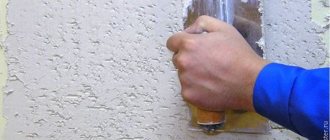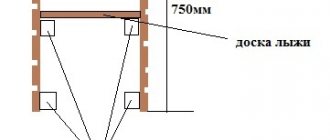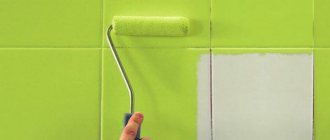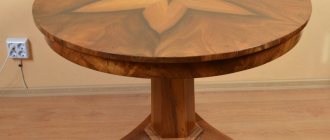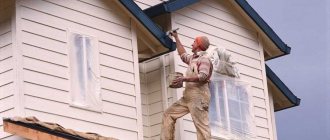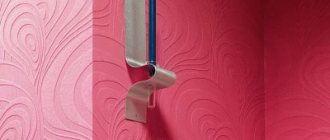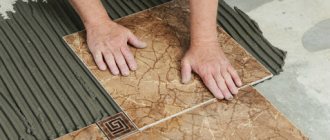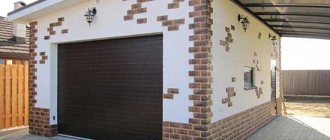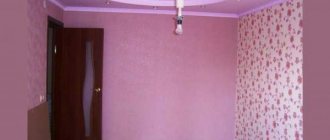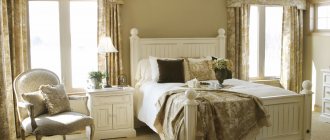Painting plywood is considered a necessary measure to protect the material from excessive moisture or other harmful environmental influences.
Currently, plywood is still often used in construction, especially private construction. It is made from thin sheets of veneer, which are glued together with adhesives of various compositions. It is used for the production of furniture, wall coverings, floors, as well as finishing the facades of buildings.
Why is plywood so popular? Durability and environmental friendliness are the main advantages of this type of building materials.
But it’s not enough to just purchase plywood and use it in its pure form for your needs. It is necessary to apply a number of measures thanks to which the plywood board can last a long time. And one of these measures is painting.
Let's look at each stage of painting plywood in more detail.
How to paint plywood on the floor
Sometimes plywood is used to treat the floor; most of all, it is used to cover the floor in dachas in utility rooms, but sometimes this coating is also used in living rooms.
The plywood itself consists of thin sheets glued together with glue. Based on the type of material used and the composition of the glue, plywood is divided into simple, moisture-resistant and laminated. In order for the plywood covering to last as long as possible, it should be covered with a protective layer of paint. But we will try to tell you how to paint plywood on the floor in this article. But before painting, you should do the necessary preliminary work. How to prepare a plywood floor for painting
•The first step is sanding the plywood floor. The surface is first rubbed with coarse sandpaper across the grain, and then with fine sandpaper along the grain. After this process, the surface should become even and smooth.
•A separate stage is processing the edges of the plywood. They are also sanded, only from the edge to the middle.
•Prime the plywood surface with impregnation of the same brand as the prepared paint. It can be applied with a roller or brush. This process is done in order to protect the surface from fungus, and also when using it, the paint fits better on the floor surface and adheres well to it.
What coating is suitable for painting plywood floors?
For painting all wooden floors, and plywood also belongs to this type of coating, the following types of paint protection are used:
•Enamel paints, which will completely cover the surface and paint over the structure of the wooden covering. Paint is used if the surface of the plywood is not ideal and has many flaws.
•The varnish will make the floor transparent, and the entire structure of the wood will be visible underneath. According to preference, the coating can be either glossy or matte. It is preferable to use a varnish coating on a floor that has no defects, since all of them will be visible under the transparent varnish layer.
When choosing what to paint plywood on the floor with, you should consider all of the above points. When purchasing paint or varnish, look through the entire color range and choose a material that matches the tone of your plywood floor.
Which varnish is best to use for painting plywood floors?
•The best option would be two-component acrylic varnishes, which when mixed produce strong varnishes that have excellent properties. Often these types of varnishes need to be stirred and they are extremely rarely available for sale already diluted, this depends on the short shelf life after they are mixed.
•Next are two-component water-dispersion varnishes. They dry quickly and are relatively moisture resistant. These varnishes should be sanded after each coat of paint, as they are water-based and will raise the lint on the surface of the wood or plywood.
•Polyurethane varnishes adhere well to the surface and have similar characteristics as the previous options.
Painting methods
Methods for refining plywood differ in both technical tools and the type of paint composition used.
As for tools, a regular brush, a roller, and a spray gun can be used. The highest quality results are achieved with the last tool. A pneumatic spray gun allows you to provide an even coating of paint and varnish.
In this case, the base layers can also be done with a brush - at this stage, maintaining a uniform layer is not so significant. In terms of choosing a coloring agent, everything is not so clear. If emphasis is required on aesthetic value, then, undoubtedly, preference should be given to construction paints - for example, acrylic or pentaphthalic compositions of the desired shade are suitable.
Painting plywood with varnish is also practiced, which involves a traditional set of tools - from a brush to a spatula. The treatment is carried out in several layers with long strokes. There are also special products for bleaching wood, which are also suitable for plywood.
They contain chlorine, sodium or potassium hypochlorites, lime, etc. It is advisable to use this option when working with plywood that is part of the structure of utility premises, rather than residential ones.
Preparation begins with thorough cleaning of the surface. It is necessary to remove both debris and dust, and weak damaged areas of the sheet. Next, you can grind the material. If plywood is being prepared for painting with varnish or the same acrylic paint, then this operation will be mandatory.
A machine with polishing abrasives will remove burrs, loose fragments and simply provide a smooth base. The second stage of preparation will be to create a reliable base for applying a decorative paint layer. For this purpose, primer putty on plywood for painting can be used, which contains strengthening and adhesive components. If you plan to use plywood outdoors, then it would be useful to include water- and frost-resistant additives in the primer.
Tips: how to paint plywood correctly
The advantage of these varnishes is that they do not need to be diluted before use.
•One-component water-based varnishes are well suited for painting wood and plywood floors. They are so durable that they can withstand grinding with a special machine, and are also well characterized.
•Alkyd-urethane varnishes can also be used for floor treatment, but they cost a class lower than those listed above and have a short service life.
•Acid varnishes are now practically not used, since they are very toxic and unstable.
•Alkyd varnishes emit an unpleasant odor, dry poorly and take a long time, and are not resistant to mechanical damage.
What paints are suitable for painting plywood floors?
If you have done all the preliminary work and are thinking about what to paint the plywood on the floor with, or rather, what kind of paint, then here you can settle on one processing option, which is considered the most suitable for all types of paints. After applying acrylic primer, which will protect the floor surface from various types of influences and damage, paint is applied. These can be all coatings intended for treating wood indoors. Choose the option you need based on your preferences and the purpose of the room. And, of course, taking into account all the characteristics of the paint.
The question of how and with what to paint plywood is relevant today. Plywood is a commonly used material made from thin sheets of veneer that are glued together with adhesives of different compositions. The moisture resistance of plywood and, in fact, its brand depend on the type of glue used. There are ordinary plywood, moisture-resistant and laminated.
Painting plywood: steps, tools, choice of paint and varnish
Plywood is a fairly common material nowadays, which is used for making furniture, partitions, and also for flooring.
The popularity of plywood is not difficult to explain: it is environmentally friendly, durable, and has an attractive price. Plywood does not require much effort when processing. In addition, products made from plywood have an attractive appearance, especially if it is painted. We’ll talk about how to properly paint plywood in this article. In addition to the aesthetic appearance, painting plywood helps protect the surface. Painting increases the service life of furniture. There is no strict procedure for painting plywood - it all depends on the working conditions and what result you want to get. The most difficult question in this matter is what kind of paint to use? The fact is that, for example, it is advisable to paint plywood furniture and plywood floors with different paints.
Paint for plywood
For painting plywood in a residential area, water-based paints, such as acrylic, are recommended. They dry quickly, have virtually no odor and apply perfectly. prepared surface.
For using plywood outdoors, regular enamel paint for wood, the so-called pentaphthalic paint, is suitable, which is easy to apply and dries quickly enough at room temperature.
Paints are sold both in ready-made colors and in basic versions - for self-tinting.
If plywood boards were stored in a damp room, they must be dried to normal moisture content before painting.
Wood painting
To paint plywood to look like wood, you can use different shades of stain. If you need a glossy surface, apply an additional layer of varnish on top.
Plywood boards are problematic materials in terms of painting. This is due to the specific texture of the surface, which does not allow for even laying of the paint and varnish composition. Such problems arise with many wood-based materials, but painting plywood is complicated by the presence of pronounced roughness and even burrs on the outside of the board.
How to paint plywood on the floor to improve moisture resistance -
When painting with a sprayer, a better result is obtained due to the uniform spraying of paint over the surface. If there is no special sprayer, choose a lint-free foam roller. To paint hard-to-reach areas, use a brush.
If you need to combine several colors when painting, use masking tape. Before painting, take care not to stain the surrounding area; cover the floor and furniture with film.
Plywood is primarily used on floors as a preparatory layer, but it can also be used as a temporary covering. The question of how to paint plywood on the floor worries everyone who has decided to use this material as a floor covering, due to the fact that it needs to be protected from moisture. Plywood has become quite popular in use due to many positive qualities, including fairly low cost, strength, environmental friendliness, ease of use and aesthetics.
Painting a plywood floor may be necessary if you decide to leave this material as a topcoat.
Before you start painting the plywood, you need to prepare it. The prepared surface should be smooth and even. In addition, additional devices are needed to carry out such a process. For example:
- roller;
- brushes;
- spray gun;
- empty containers (you can use special ones, you can also use simple buckets or basins);
- sandpaper (if cleaning is necessary);
- soft sponges.
Instructions for applying the composition
If the choice falls on a brush or roller, then the actions should be performed smoothly and without jerking. It is recommended to cover as large an area as possible in one pass, which will minimize smudges and make the coating uniform. At the same time, it is better not to limit yourself to one layer - on average, this design is performed in 2-3 passes.
If you are preparing to paint a plywood floor, you should count on 5-6 layers, since this coating will require increased mechanical resistance. The easiest way to work is with a spray gun. It sprays the composition evenly over the entire area and the user can only monitor the abundance of coverage. In this case, leaks are also possible, but this effect can be avoided if you perform intensive movements of the working head of the tool.
Preparation for painting
Before painting plywood on the floor, it is advisable to perform several operations, thanks to which the plywood will last longer:
Before laying plywood, it must be sanded.
- Sand the surface with 80-grit sandpaper.
- Cover with acrylic primer.
- Dry.
- Treat with acrylic wood putty.
- Dry.
- Sand with 80-120 sandpaper.
- Prime.
- Dry.
- Color.
You can do without all these steps, but in order for the plywood floor to be reliably protected from water and fungus, it must be opened with acrylic primer.
The alkyd primer is applied with a roller, and then the surface is painted with acrylic or alkyd paint, but keep in mind that alkyd paint takes longer to dry. If you are not bothered by structural relief appearing on the painted surface, you can reduce the number of steps. And occasionally you can limit yourself to just priming and painting.
Processing plywood before painting
Before painting, plywood must be completely cleaned of dust and small sawdust. Plywood sheets should be painted along the wood grain.
Do not forget that before preparing plywood for painting and staining, the sheet must dry thoroughly. Everyone knows the property of this material - to warp.
You can avoid the risk of deformation by simply keeping the sheets in a dry room at room temperature for 3-4 days. This is especially true if the material was stored on the street or in a damp construction warehouse. Experts recommend not neglecting this stage and keeping the material for several days in the room where you then plan to paint it.
Initially, the sheet must be sanded to remove any irregularities.
This stage can only be avoided if you purchase high-grade material. It's already quite high quality. For cheap varieties, sanding is highly desirable.
First, use coarse-grained sandpaper (No. 80-100), and then use medium-grained sandpaper (No. 100-120). This improves the subsequent adhesion of the surface to the paint. Do not forget to process the edges of the sheets; if they are too rough, they can be lightly planed and then sanded.
If you need to hide joints, fasteners or very noticeable defects, use putty. This material will also be useful to you if you decide to glue wallpaper onto plywood. Don't forget to sand the putty areas
After grinding is completed, the surface must be primed; most often, drying oil, primers with an alkyd base, or special compounds that fill the pores of the material are used for this.
For large volumes of work, it is recommended to use electric grinders. They will save time, make work easier and improve its quality.
Paint selection
For plywood, you should choose water-based paints.
When choosing paint, you need to consider where the painted plywood will be used. The main purpose of the paint is to protect the plywood from cracks that appear due to high humidity.
In order to paint plywood floors, it is recommended to use water-based paint. These paints dry quickly, have virtually no odor, and are easy to apply.
To paint plywood, elastic paint is used, which has a rubber-like structure, is glossy and is resistant to ultraviolet radiation. This coating allows you to give a new look to old plywood. Among the advantages of elastic paint are resistance to noticeable temperature changes; the formation of a thin film that hides small cracks, irregularities and all kinds of flaws.
Priming and puttying plywood
- The next step is priming the surface. A primer is necessary to protect the plywood from moisture, mold and rot in the future. It is best to use an acrylic-based primer for plywood. It penetrates deep into the layers of plywood, which helps to avoid cracking of the plywood during its operation. The primer also promotes better adhesion of the paint to the surface.
- After priming, if there are cracks or chips on the surface of the plywood, it needs to be puttied. Putty will level the surface. After the putty has completely dried, the surface must be sanded again.
Varnishing tips
If the varnish is applied to an unpainted surface, it must be sanded in advance using fine-grained abrasive paper. After sanding, the resulting dust must be thoroughly removed, and the plywood should be opened with diluted varnish.
The varnish can also be applied to painted plywood to add shine. To do this, you need to make sure that the painted surface is dry, then you can open it with a layer of varnish. When using glossy paint, you do not need to apply varnish.
To make plywood shine, it must be varnished.
In order to paint plywood floors, alkyd-urethane-based varnishes are used, which are considered the best option in terms of price and quality ratio. You can use varnish with a urethane or polyurethane base. They are wear-resistant types, but are more expensive.
Urethane or polyurethane-based varnishes are more expensive, but also more wear-resistant.
Sequence of applying varnish to plywood:
- First you need to apply 2-3 layers of primer.
- If you use alkyd-urethane varnish with the addition of white spirit, then for priming it is necessary to dilute it by adding 10-12% white spirit. 1 liter is enough to treat 13-17 m2.
- To dilute water-based varnish, use water in the proportion of 4 parts water and 1 part varnish. 1 liter of this solution can treat 8-13 m2.
- Then apply 2-3 layers of undiluted varnish. For 9-13 m2 you will need 1 liter of varnish.
- The layers must be applied at intervals specified by the manufacturers. Approximately, it takes 5 hours to dry one layer, and you can walk on it after a day, and it dries completely after 4 days.
- If the varnish is water-based, then walking is allowed after 12 hours, and the floor dries completely after a week.
Preparation of the plywood surface
Increasing the service life of materials makes it possible to spend less money during routine and major repairs.
In our case, it is best to use acrylic paints and varnishes. Processing plywood before painting with a sander
Let's divide the process into several steps:
| Sanding and finishing edges |
|
| Priming and puttying | Process instruction:
Do not forget to remove all uneven surfaces with putty, and after it dries, you should clean and sand everything again. |
Advice: if the structure of the relief appears, it will not create interference. In this case, it is enough to apply one coat of paint over the primer.
Applying paint
Let's find out what is the best way to paint plywood inside a house. In this case, the main role is played by how the material will be used in the future. For example, the more layers of paint on the surface, the better the sheet will withstand the effects of humidity.
If you haven’t decided how to paint the plywood in your house or apartment, use a regular roller, brush and acrylic wood paint for interior work.
Advice: in places with high humidity, in particular outdoors, plywood sheets should be covered with several layers of paint on both sides, and not just on the outside.
How to varnish a plywood sheet with your own hands:
- take fine-grained sandpaper and carefully sand the desired area;
- Using a vacuum cleaner and a damp cloth, remove any remaining dust on the surface of the product, wait until it dries;
- apply paint to the surface of the plywood;
- top it off with varnish to create extra shine.
Tip: If you are using glossy paint, do not use varnish.
What tool will you need?
Before deciding how to paint plywood against moisture, let’s figure out which tool should be prepared for this.
Typically used:
- brush;
- roller;
- spray.
Thanks to the latter, it is possible to achieve quite decent quality of work, since it allows the paint to be evenly distributed over the surface. Its price is usually high, so foam rollers that do not have lint are often used in home construction. Brushes are used in hard-to-reach places.
Tip: Use masking tape to differentiate colors between each other on the floor or wall.
Selecting colors
Based on the type of thinners, they can be divided into the following categories:
- Alkyd paints are highly durable and can retain their original appearance for a long time. Due to the fact that they cope well with moisture, we recommend that you use them if you have not yet decided how to paint the plywood on the floor in your dacha.
However, to dilute them use:
- White Spirit;
- drying oil;
- turpentine.
They have a very pungent odor. Alkyd composition is not environmentally friendly, therefore, if you have not decided how to paint plywood outdoors, we recommend using it;
If you haven’t decided what to paint your plywood floor with, we recommend acrylic enamel
- Water-dispersion paints are diluted using ordinary water. In this case, all the signs of environmentally friendly compositions are evident, which is confirmed by the almost complete absence of any odors. After drying, a fairly strong, albeit thin film is formed on top.
There are several types of such paints:
- water-based - they can be applied to almost any surface. The compositions are resistant to temperature changes and can easily be applied to another type of paint. In addition, the material is generally non-toxic;
- latex - have high moisture-resistant properties, as well as abrasion resistance. Allows you to close cracks up to 1 mm. After application, a glossy coating is created. The disadvantages are that they do not tolerate low temperatures well and do not protect against mold;
- silicate – high quality coating at low cost of the compositions. Disadvantage - there is alkali, which is why it is necessary to take additional safety measures during work; they are not used with other paints;
- silicone - create very elastic coatings, allowing you to hide cracks up to 2 mm. Long service life, not afraid of moisture, so if you haven’t decided how to paint plywood against moisture, you can use them. The compositions do not react to temperature changes. But, the cost of the material is quite high;
Acrylic paint is best for painting indoors
- acrylic - after drying, a high-quality layer is created on the surface that is resistant to moisture;
- polyvinyl acetate compounds are used for rooms with low humidity. Please note that over time they may develop a yellow tint.
If you have not yet chosen the appropriate composition for painting plywood sheets inside a residential building, or have not decided how best to decorate plywood crafts, give preference to water-based paints that have the following characteristics:
- easy to apply;
- almost odorless;
- dry quickly.
In the photo - Belinka enamel for exterior use
For exterior work, it is better to use wood enamel or pentaphthalic paint. Before applying it, the plywood should be thoroughly dried, otherwise the composition will swell in damp places.
Practical recommendations
If you want to paint plywood to match a wooden plank floor, you must follow these steps:
To give plywood the appearance of laminate or parquet, it must be covered with stain.
- Carefully select plywood sheets according to the texture of the fibers.
- Select sheets without knots and damage or with a minimum number of them.
- Fit the sheets according to the drawing.
- Sand the outer surface with sandpaper.
- Cover with stain of the desired color and tone intensity.
- Sand.
- Carefully putty the joints and sand all seams.
- It is important to choose a putty tone that is as close as possible to the tone of the surface. Often, to seal the seams, waterproof PVA-based putty is used, to which a suitable dye is added.
- After the seams have been cleaned, you need to remove any dust that has appeared and cover it with 2-3 layers of parquet varnish.
To paint plywood, you can use a sprayer, roller or brush.
When a sprayer is used, the painting result is of a higher quality, which is a consequence of the equal dispersion of the paint. If you don’t have a special sprayer, you can use a lint-free foam roller. Use a brush to paint hard-to-reach areas.
If it is necessary to combine several colors when painting, it is advisable to use masking tape.
Thin sheets of veneer glued together are widely used in construction and the production of various products. Finishing the surface gives the canvas greater moisture resistance and strength. So let's figure out how to paint plywood? The final finishing is simple, does not require professional skill, and is carried out using suitable paint.
How to paint plywood
Plywood can be painted with a foam roller, brush, or use a sprayer.
A sprayer should be chosen if the area to be painted is large enough. Paint the edges with brushes of different sizes.
The paint can be used either ready-made or as a base. Colored dyes are added to the base, tinting it to the desired shade.
As a rule, paint is applied to plywood in 2-3 layers. In general, the number of layers may vary. Depending on what effect you plan to achieve in the end.
To apply only varnish to the surface, the plywood must be additionally sanded with fine-grain sandpaper along the grain and the surface degreased. Next, apply the first layer of varnish.
The first coat of varnish will raise the lint on the plywood. Therefore, after the first layer of varnish has dried, the surface must be sanded again. And then apply the remaining layers of varnish.
What and how to paint plywood should be chosen based on the nuances described above.
Plywood is considered a popular material for decoration, as well as for furniture production. Demand for it is growing due to its low cost, and the material itself consists of several thin sheets of veneer glued together. When carrying out repair work, painting of plywood is often required: in order to do this efficiently, you need to familiarize yourself with the sequence of the procedure, as well as choose the right paint composition.
Paint and materials
When choosing materials and tools for work, you should consider the following:
- Future operating conditions of painted plywood. If the sheet will be in an open space or in a damp room, it is better to paint it with acrylic pigment. The emulsion is applied twice, all sides of the canvas and ends are processed;
- Characteristics of the material to be painted. If the canvas contains phenol-formaldehyde glue, facade paint for plywood is suitable;
- Is a spectacular appearance important? Plywood for furniture is painted with water-based compounds;
- Conditions, scope of work. The choice of tool is determined by the nature of the surface, its area, and accessibility to painting.
Antiseptic treatment protects plywood from fungi and mold
Pigments
How to paint plywood inside a house? Water-based compositions, for example, acrylic, are suitable for this. This pigment dries quickly, does not smell, and is easily applied to the treated surface. If the plywood sheet will be used outdoors, it is better to paint it with ordinary wood enamel. This paint is called pentaphthalic. The composition is easy to apply and dries quickly in a warm room. Paints are available for sale ready-made or as a base, which requires independent tinting.
The painted sheet can be varnished. This treatment gives the surface additional gloss. In this case, it is important to ensure that the wood panel is completely dry before applying the composition. If the pigment already contains gloss, varnishing is not necessary. Alkyd-urethane varnish is considered the best option for the combination of price and quality. Urethane and polyurethane compounds are also suitable for processing. They have increased strength characteristics and higher cost.
The composition should be applied in two layers if a rich shade is required.
Auxiliary materials
What tools can you use to paint a plywood sheet? The fabric is processed using:
- Sprayer. The pigment is evenly distributed over the surface. The downside of the tool is its high cost;
- Roller. For work, it is better to choose a standard foam tool;
- Tassels. The tool is well suited for painting hard-to-reach areas.
Tool and paint
To paint plywood you need any of the following tools:
- roller;
- paint brush;
- spray.
Which of the listed tools to use depends on the type and area of the surface to be painted. It is better to use a roller for painting smooth, medium-sized surfaces (cabinets, wardrobes). It is desirable that the roller be foam rubber. In this case, using a fur roller for painting is inconvenient - it leaves lint on the surface. A brush is an indispensable tool for painting edges, corners, and various shaped elements. Well, a sprayer will save a lot of time when painting large, flat areas, such as a floor.
As for the type of paint, you need to pay attention to the following factors:
- the conditions in which the plywood product will be located;
- class of material to be painted;
- purpose of painting.
If painted plywood will be located outdoors or in a room with high humidity, it is recommended to use acrylic paint. The paint layer is applied in two layers. In this case, both sides of the sheet, as well as the ends, are processed.
If phenol-formaldehyde glue was used in the manufacture of plywood, then facade paint will be required. This paint is also used for coloring wood. Plywood, which is used to make furniture, is treated with water-based paint. This paint has a number of advantages:
- dries quickly;
- no unpleasant odor;
- high-quality adhesion to the surface.
The purpose of painting refers to the appearance of the surface. That is, is it necessary to emphasize the beauty of the surface being painted or is there no such task.
Recommendations for varnishing
When starting to process the canvas, you should take into account some nuances. To get a good result and avoid unpleasant consequences, you need to:
The composition should be applied evenly in the direction of the wood fibers
- when painting plywood with acrylic paint indoors, cover furniture and floors that cannot be treated with polyethylene;
- choose a suitable putty to match the pigment used;
- apply the composition evenly along the wooden fibers;
- do not allow the formation of too thick a layer of pigment, which leads to the appearance of smudges;
- apply the composition in two layers if you need to create a rich shade;
- Use masking tape when combining different colors.
Painting
Now you can start the main work - painting. It is advisable to paint plywood sheets in the longitudinal direction, along the wood fibers. The paint layer must be applied evenly. The layer should be thin. If the paint is applied in a thick layer, this can lead to the formation of smudges, which will lead to a deterioration in the appearance of the surface. In addition, applying a thin layer helps to better saturate the color of the paint. It is recommended to apply a second coat to the painted layer. Before applying the second layer, you need to wait a certain time so that the first layer is completely dry.
Instead of paint, the surface of the plywood can be treated with varnish. In this case, the plywood also needs to be thoroughly cleaned with fine-grained sandpaper. After this, the entire area to be treated should be degreased and cleaned of fine dust and dirt, otherwise all this will be visible under the layer of varnish.
Then we apply the first layer of varnish and give it time to dry. Any minor hairiness that appears after this should be removed by sanding. Then apply another layer of varnish. As a result, the surface will become matte. If you want the surface to be glossy, you will need to apply another coat. It is recommended to apply the final coat of varnish using a sprayer. This will allow you to get a more uniform layer. Alternatively, in this case, you can use a lint-free paint roller. The varnish can also be used after applying paint to the plywood. If you apply a layer of varnish on top of the paint, the surface will become glossy and shiny. However, it is easier to use glossy enamel for this purpose.
Questions
How to paint plywood inside a house?
For interior decoration, various water-based paints are used - acrylic, latex. You can paint the canvas with wood enamel, otherwise called pentaphthalic. The composition is easy to apply, penetrates well between the fibers, and dries instantly.
What paints can you use to paint on plywood?
The wood canvas holds oil and acrylic compositions well, even gouache and watercolor. The sheet must be at least 6 mm thick. The surface must first be primed or impregnated with drying oil similar to oil.
Painting on the surface
How to paint plywood white?
To obtain a high-quality white surface without visible minor defects, matte paint is required. Glossy compounds are less able to hide flaws in the base. Before work, you also need to carefully prepare the surface.
How to paint plywood on the floor?
Elastic paint is well suited for finishing flooring. This composition has a rubber-like structure, a shiny appearance, and is resistant to ultraviolet radiation. The pigment forms a thin film, hides minor flaws, and conceals unevenness.
How to paint plywood against moisture?
The easiest way to protect the surface from moisture is to impregnate the sheet with drying oil or acrylic varnish. Another effective, but more expensive option is to paint the canvas with epoxy resin.
How to glue
When doing decorative work, sometimes it becomes necessary to glue the slab. The procedure for preparing the sheet is quite simple. First, the surface is sanded with fine-grained sandpaper and wiped with a damp cloth, removing dust. This technique works with regular plywood. If a PVC layer is applied, for example with a laminated material, this should also be cleaned with sandpaper. Then the surfaces are dried. After this they start gluing.
Here you should choose the composition of the glue. The task is not easy, since many factors must be taken into account: plywood operating conditions, humidity, gluing technology, sheet strength, etc.
The following adhesive connections are used:
- PVA is a white or colorless composition. Adheres well, can only be used for interior decoration;
- epoxy resin – durable and resistant to external weather influences. Used for gluing to metal profiles and other products;
- polyurethane glue;
- contact adhesives - usually used on large areas and surfaces;
- phenol-based adhesive - like epoxy resin, it is durable and resistant to adverse weather conditions.
If the top film of laminated plywood is not removed, it will prevent the layers from fitting tightly when gluing, which will subsequently lead to the sheet falling off. As we said above, the melamine film must be cleaned off during preparatory work.
The glue is applied with a wide brush or roller. If the glued surfaces allow this, you can make a clamp for better adhesion of the adhesive composition. It is best to remove excess adhesive before it hardens.
Painting process
There are several ways to paint plywood:
- Painting along the wood grain line . Paint is applied over the entire sheet in the same amount. The paint should be applied in a small layer. Applying paint in a large layer risks the formation of lumps, which can ruin the entire appearance of the plywood. After the first coat has dried, it is best to begin applying the next coat of paint.
- An alternative to paint can be varnish . Before varnishing, the surface of the plywood must be made smooth. Varnish, like paint, is coated in two layers. After the first coat has dried, it must be sanded and then a second coat must be applied.
Advice! When painting plywood, it is necessary to cover all pieces of furniture located next to the plywood with film.
- You can simply bleach the plywood. For this purpose, special products containing chlorine are used.
Plywood can be painted with acrylic or oil paint. Acrylic - has a fairly high cost and is not very safe. By following the advice in this article, you will definitely be able to paint plywood correctly, and you will be satisfied with your result.
How to choose paint?
In order to decide on paint, you need to decide for yourself why the plywood will be painted, and under what conditions it will be exposed. For open spaces, paint with the addition of acrylic is best suited. This paint should be applied in two layers on each side of the plywood.
Facade paint is well suited for plywood, which contains glue with phenol-formaldehyde particles.
Water-based paint is well suited for plywood used in furniture making. Its advantages are that it has virtually no odor, dries quite quickly and is applied very well to the surface.
How to cut plywood with a circular saw
Sawing plywood with a circular saw
When cutting using a circular saw, the blade must be suitable for the plywood sheet. I recommend using a blade with 80 teeth or more. When you use a circular saw, you don't have to worry about the underside of the plywood sheet because the tearing only happens on the top side. This is the easiest way to get a clean cut.
The duct tape trick also works on a circular saw, but it may be easier to make a light cut along the cut line and then cut it down.
Compact and powerful hand-held circular saw for cutting plywood
How to apply moisture impregnation to plywood?
- Process elements that are already prepared for installation (cut exactly to size).
- Drying oil, varnish, paint, oil are applied with a soft brush with fine bristles or a roller. You can use a spray bottle.
- It is necessary to apply impregnation to plywood only along the fibers.
- Sheets must be in a horizontal position.
- Each layer should dry for at least 10-12 hours.
- If residues form during the application process, remove them with a soft cloth.
- The sheets are primed and painted on both sides.
Compliance with coating technology will allow you to obtain a product that will serve you for many years without changing its appearance or physical properties.
All articles
Application of paint
You can also paint the plywood on the ceiling. Their selection is very wide. Paints can be divided into different types.
According to invoice:
- Glossy. They look beautiful, but if the surface being coated is not so ideal, then defects will be visible;
- Matte. Perfectly hides minor defects.
By type of thinner:
- Alkyd. Paints based on this are quite durable and retain their appearance for a long time. Negative properties include the fact that white spirit, turpentine, and drying oil, which have a pungent odor, are used as solvents. Paints based on this material are not environmentally friendly and are best used for exterior painting.
- Water-dispersed. These paints are diluted with water. They are environmentally friendly, practically odorless and, after drying, form a fairly durable thin film.
Water-dispersion paints are divided into such groups as: water-based, latex, silicate, silicone, acrylic, polyvinyl acetate.
Water-dispersion paints, in turn, can be divided into groups:
- Water-based paints. Can be easily applied to almost any surface. Resistant to temperature changes. Any other types of paints can easily be applied to them. Non-toxic.
- Latex paints are the most expensive among water-based paints. They have high moisture-resistant properties and abrasion resistance. Surfaces painted with these paints remain “breathable”. Their high covering ability allows you to cover cracks up to 1 mm. It is this paint that creates a glossy finish. The disadvantage of latex paint is its “intolerance” to low temperatures: fungus and mold can form on the painted layer.
- Silicate paints. Their advantages include low cost and fairly durable coating. Negative aspects: the paint contains alkali, which requires compliance with safety measures when working with it; “intolerance” to high humidity; incompatibility with other types of paint.
- Silicone paints. They have many advantages compared to other types of water-dispersion paints. The highly elastic coating can hide cracks up to 2mm. Durable. They have high water-repellent properties. Resistant to large temperature changes. The disadvantage is the high cost.
- Acrylic paints. After drying, they form a durable layer that is resistant to moisture.
- Polyvinyl acetate paints are a cheap option for rooms with low humidity. Over time, this paint acquires a yellowish tint.
The question of how, and most importantly, with what to paint plywood on the floor, is very relevant these days. Plywood is a material with excellent characteristics that has a fairly wide range of applications.
It is made from fairly thin sheets of veneer, glued with adhesives of different compositions. Such a property of this material as moisture resistance and, accordingly, the brand directly depend on the composition of the glue used.
Self-painting technology
As noted above, before properly painting plywood, you should choose a tool. It is better to paint large wood boards using a sprayer, and medium-sized plywood can be treated with a roller. Brushes are needed to paint a narrow space, while a sponge can be used to cover small-sized home decor.
Painting plywood with a roller
The painting technology looks like this:
- Creating the required consistency. Before painting plywood with acrylic paints, they can be diluted with water. If the work is carried out with enamel, it is diluted with solvent or white spirit.
- First, you need to use a brush, treating all hard-to-reach places with it: this procedure will allow you not to repaint the base in the future.
- Using a convenient tool – a roller or spray gun – you need to paint the remaining part of the surface. Painting the wall should occur with vertical and horizontal movements.
- After the first layer has completely dried, you can go over it again with the same colored paint for brightness.
- The last stage is varnishing. Regardless of the style, purpose or color scheme, plywood products must be varnished. It can be either glossy or matte. After drying, the material is ready for use; if necessary, you can coat the plywood with another layer of varnish.
Plywood can be painted antique: to do this, it is enough to apply black paint after priming and sanding, and after it dries, apply light paint. When the surface is dry, it must be treated with coarse sandpaper and varnished. This option is suitable for painting antiques, loft-style interior items, and vintage collectible furniture.
In the photo: a spray gun is a convenient tool when painting without visible brush marks is required. It is also useful for large volumes of work.
When working externally, for example, on a summer cottage when painting a plywood veranda, as well as when using wood in a bathroom, you should additionally treat the surface with antibacterial solutions - they will protect the material from fungus.
Decorative items turn out beautiful: the painted material can be used as a basis for further creativity. You can depict a flower or landscape on it, using the product for a tabletop in the future. By skillfully using an old bristle brush, you can visually transform plywood into marble, plastic or metal, creating an imitation of them on the surface with sharp transitions. A handy tool like a laser level will help you make precise markings on the surface to be painted.
Following simple tips and rules will help you paint plywood with various types of paints efficiently and beautifully. A competent choice of primer, putty, paint and varnish will help extend the life of the product, maintaining its original appearance.
Preparing for painting
The plywood preparation process takes place in several stages:
- Everyone knows the conditions in which plywood is stored in a warehouse, so when you buy plywood, it may be a little damp. The first step is to dry it completely. To do this, the plywood needs to lie in a dry room for about a day. This is a necessary condition before painting;
- The next step will be to clean the plywood surface from burrs and dust . First, its surface must be treated with sandpaper, and then treated with special sandpaper;
- The cleaned surface must be treated with a primer. This is necessary so that the plywood sheets do not change their shape. If a sheet of plywood is treated with a primer, then the paint will adhere to its surface in the best possible way;
Advice! After the primer has completely dried, it is best to treat the plywood sheet with antiseptics, this will prevent the appearance of fungus.
Choosing plywood for painting
Plywood production technology provides for the production of several categories of products:
- FC. This moisture-resistant material is used for making furniture and for interior decoration.
- FSF is a sample with increased moisture resistance, intended for roofing work. It is used where good wear resistance is required.
- Laminated (FOF) board has a special protective coating.
- Bakelite material with fiberglass reinforcing mesh
The nature of the staining depends on the degree of processing of the plywood and its grade.
There are 3 options for finishing sheets:
- NS – without grinding;
- Ш1 – with processing of 1 side;
- Ш2 – with grinding of both sides.
The grades reflect the external condition of the material, thereby determining the scale of preparatory work before painting.
- Elite (E) class plywood. It is distinguished by the absence of knots and other surface defects.
- I grade. Here, the presence of 5 knots up to 1.5 cm long per 1 square meter is allowed. m.
- Material of grades II and III has veneer inserts, scratches, and dents. Knots and marks from them may be visible, as well as glue residues on the edges. The presence of cracks up to 20 cm per 1 square meter is acceptable. m. The number of defects and their quality determines the grade of the samples.
- Grade IV may contain any types of flaws while maintaining the technical characteristics of the material.
Before painting plywood received from the warehouse, it is allowed to rest. If the temperature in the room coincides with the temperature regime of the storage, you can start working after 24 hours, if the difference is 2-8°C - after 3 days. If this difference is greater, then you need to wait a week.
How to make furniture from plywood
DIY plywood furniture
If you have never created objects from plywood with your own hands, then you should think about it now. When purchasing finished products, you overpay for assembly. And often when we buy ready-made parts, we overpay for manual work on them. It will be much cheaper to create by hand from available materials such as plywood.
Plywood kitchen set with built-in appliances
Before you start creating plywood furniture with your own hands, you should decide on the design of the structure. Perhaps you will find a suitable drawing on the Internet, or maybe you can draw it yourself. Familiarize yourself with the selection and processing of materials before starting work.
DIY cutting of a plywood chair according to the drawing
